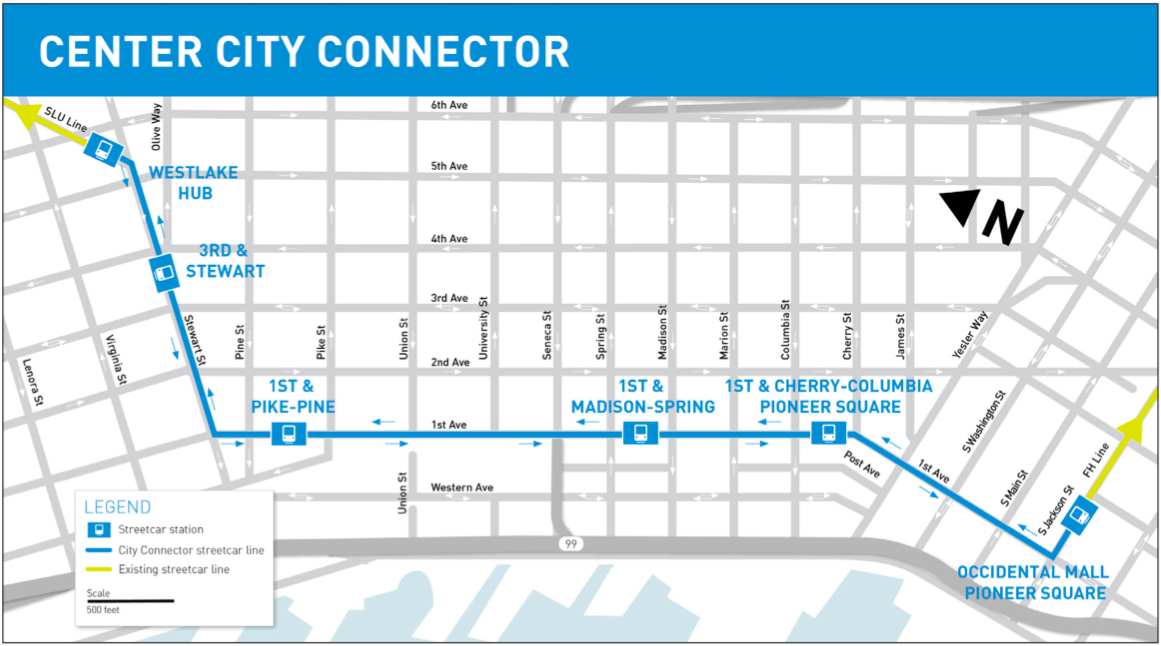Seattle's 2.5-mile First Hill Streetcar is a modern streetcar that, like many American streetcars operating in mixed traffic, just isn't performing that well.
The line cost $134 million to construct and opened in 2016, carrying 3,000 riders a day that year. In 2017, ridership dropped 30 percent.
Despite the low ridership, Seattle was planning to keeping laying down track in mixed traffic with a "Center City Connector" streetcar linking the First Hill Streetcar with the South Lake Union Streetcar on the other side of downtown.
By creating a single continuous route, officials believe the project would make the older streetcar segments more useful, boosting ridership on the corridor from around daily 6,000 trips on the two disconnected routes to 24,000 on the combined route. The city has lined up a $75 million federal grant for the project but construction has yet to begin.
The project might not get built. Mayor Jenny Durkan isn't sure this streetcar project is the best use of Seattle's transit resources and has asked her staff to review other options, Doug Trumm at the Urbanist reports.
Like other cities that have built low-ridership streetcars, Seattle is facing a choice: keep throwing money at a mode of transportation that hasn't paid off, or stick with it in the hopes that more people will ride routes that connect more places.
Seattle may be throwing good money after bad if it builds the next streetcar segment, but backing out now carries its own risks, Trumm writes:
Just what are these other options Mayor Durkan is mulling?
The obvious choice is bus service. However, many obstacles stand in the way of converting the connector to a bus project. For starters, the bus option would lose $75 million in federal grants. With federal transportation grants mainly going to Red states under the current administration, now is not a good time to be a Blue state at the back of the line for grants. Connecting two disconnected streetcar stub-lines has real value that a bus line cannot easily replicate. Only by decommissioning the other two streetcar lines could one create a single efficient rapid bus line. Short of that, the city would only create a messy patchwork where bus service sutures together the the South Lake Union and First Hill streetcar lines but does not correct a situation where streetcar ridership continues to lag. It would also continue the pattern of short-changing First Hill.
And if the bus alternative is supposed be on par with the quality planned for the center city streetcar, it will likely cost nearly as much as a streetcar, though with less covered by federal grants. Center-running transit-only lanes require redesigning the street and purchasing new buses with doors on both sides. For comparison, look to the Madison Street’s RapidRide G Line project which is budgeted at $120 million for 2.5 miles. Recreating Seattle’s planned streetcar loop as a rapid bus line may end up costing more than $200 million if the RapidRide G Line’s costs are indicative. The Center City Connector is a 1.2-mile extension to bring the streetcar network to five miles in length. At twice the length of the $120 million RapidRide G Line, a five-mile-long center city bus rapid transit line would not be cheap.
SaveSave
SaveSave
SaveSave





